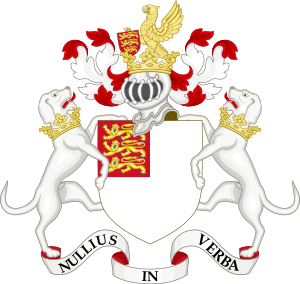
The Royal Society's coat of arms.
The President of the Royal Society is the leader of a very old and famous group called the Royal Society. This person is chosen to lead meetings and guide the society. The Royal Society is also known as the Royal Society of London.
How the Royal Society Started
The Royal Society began on November 28, 1660. A group of smart people, including Christopher Wren, met and decided to create a "College for the Promoting of Mathematical Experimental Learning." This was a place to encourage new ideas and experiments in math and science.
King Charles II officially recognized the group on July 15, 1662. He gave them a special document called a Royal Charter, making them the "Royal Society of London." The first president chosen by the King was William Brouncker. The Charter also said that future presidents would be elected every year on November 30, which is St. Andrew's Day.
Changes Over Time
At first, there was no limit on how long a president could serve. Some presidents stayed for many years! In the past, wealthy people were sometimes chosen as presidents because they could help the society with money.
However, by the 1800s, people wanted presidents to be chosen for their scientific knowledge, not just their wealth. So, in 1847, the society decided that members would be chosen only for their scientific achievements. Since the 1870s, most presidents have served for exactly five years. Today, a president cannot serve for more than five years.
What the President Does
The President of the Royal Society has important jobs. They used to be one of the few people who could approve certain experiments on animals, making sure they were done properly. They also acted as an important advisor to the government on science matters.
Besides their official duties, the president also helps welcome important visitors and scientists from other countries. It's a mix of serious work and social events.
Modern Presidents
The change to a new president happens around November 30 each year. Many recent presidents have been very famous scientists. Since 1901, 18 of the 26 presidents have won a Nobel Prize for their amazing discoveries in physics, chemistry, or medicine. Many have also received a special honor called the Order of Merit.
The longest-serving president was Sir Joseph Banks, who led the Royal Society for 42 years, from 1778 to 1820. The current President is Sir Adrian Smith, who started his five-year term on November 30, 2020.
Presidents of the Royal Society
List of presidents of the Royal Society from 1662 – till date.
| No. |
Term |
Portrait |
President |
Profession |
| 1 |
1662–1677 |
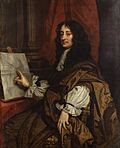 |
William Brouncker, 2nd Viscount Brouncker |
Mathematician |
| 2 |
1677–1680 |
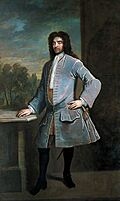 |
Sir Joseph Williamson |
Civil servant and politician |
| 3 |
1680–1682 |
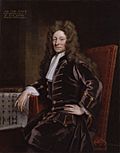 |
Sir Christopher Wren |
Architect, astronomer and physicist |
| 4 |
1682–1683 |
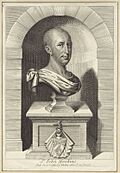 |
Sir John Hoskyns, 2nd Baronet |
Lawyer |
| 5 |
1683–1684 |
 |
Cyril Wyche |
Lawyer, politician and administrator |
| 6 |
1684–1686 |
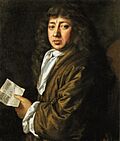 |
Samuel Pepys |
Civil servant and politician |
| 7 |
1686–1689 |
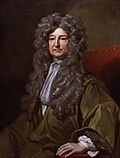 |
John Vaughan, 3rd Earl of Carbery |
Politician |
| 8 |
1689–1690 |
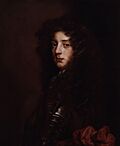 |
Thomas Herbert, 8th Earl of Pembroke |
Politician |
| 9 |
1690–1695 |
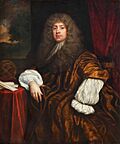 |
Sir Robert Southwell |
Diplomat |
| 10 |
1695–1698 |
 |
Charles Montagu, 1st Earl of Halifax |
Poet and Statesman |
| 11 |
1698–1703 |
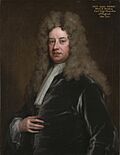 |
John Somers, 1st Baron Somers |
Jurist and Statesman |
| 12 |
1703–1727 |
 |
Sir Isaac Newton |
Physicist, mathematician, astronomer, natural philosopher, alchemist, and theologian |
| 13 |
1727–1741 |
 |
Sir Hans Sloane, 1st Baronet |
Physician and collector |
| 14 |
1741–1752 |
 |
Martin Folkes |
Antiquarian |
| 15 |
1752–1764 |
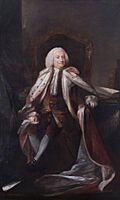 |
George Parker, 2nd Earl of Macclesfield |
Astronomer |
| 16 |
1764–1768 |
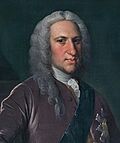 |
James Douglas, 14th Earl of Morton |
Astronomer |
| 17 |
1768–1768 |
 |
Sir James Burrow |
Legal reporter |
| 18 |
1768–1772 |
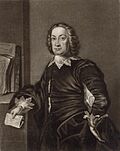 |
James West |
Politician and antiquarian |
| 19 |
1772–1772 |
 |
Sir James Burrow |
Legal reporter |
| 20 |
1772–1778 |
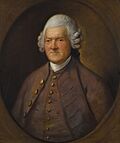 |
Sir John Pringle, 1st Baronet |
Physician |
| 21 |
1778–1820 |
 |
Sir Joseph Banks |
Naturalist and botanist |
| 22 |
1820-1820 |
 |
William Hyde Wollaston |
Chemist |
| 23 |
1820–1827 |
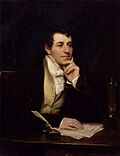 |
Sir Humphry Davy, 1st Baronet |
Chemist and inventor |
| 24 |
1827–1830 |
 |
Davies Gilbert |
Engineer, author and politician |
| 25 |
1830–1838 |
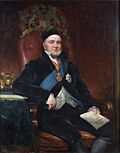 |
Prince Augustus Frederick, Duke of Sussex |
Sixth son of George III of the United Kingdom |
| 26 |
1838–1848 |
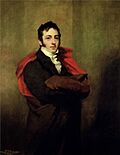 |
Spencer Compton, 2nd Marquess of Northampton |
Nobleman |
| 27 |
1848–1854 |
 |
William Parsons, 3rd Earl of Rosse |
Astronomer |
| 28 |
1854–1858 |
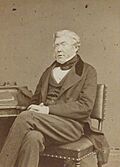 |
John Wrottesley, 2nd Baron Wrottesley |
Astronomer |
| 29 |
1858–1861 |
 |
Sir Benjamin Collins Brodie, 1st Baronet |
Physiologist and surgeon |
| 30 |
1861–1871 |
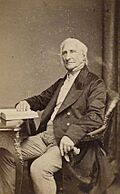 |
Sir Edward Sabine |
Astronomer, geophysicist, ornithologist and explorer |
| 31 |
1871–1873 |
 |
Sir George Biddell Airy |
Mathematician and Astronomer |
| 32 |
1873–1878 |
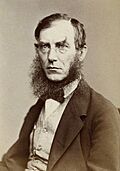 |
Sir Joseph Dalton Hooker |
Botanist and explorer |
| 33 |
1878–1883 |
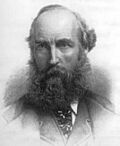 |
William H. Spottiswoode |
Mathematician and physicist |
| 34 |
1883–1885 |
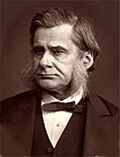 |
Thomas Henry Huxley |
Biologist |
| 35 |
1885–1890 |
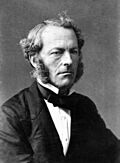 |
Sir George Stokes, 1st Baronet |
Mathematician and physicist |
| 36 |
1890–1895 |
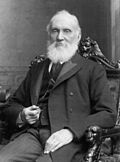 |
William Thomson, 1st Baron Kelvin |
Mathematical physicist |
| 37 |
1895–1900 |
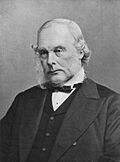 |
Joseph Lister, 1st Baron Lister |
Surgeon |
| 38 |
1900–1905 |
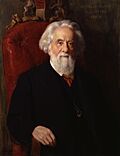 |
Sir William Huggins |
Astronomer |
| 39 |
1905–1908 |
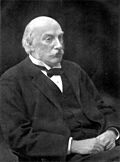 |
John William Strutt, 3rd Baron Rayleigh |
Physicist |
| 40 |
1908–1913 |
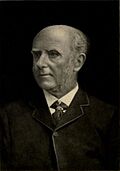 |
Sir Archibald Geikie |
Geologist and writer |
| 41 |
1913–1915 |
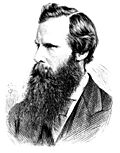 |
Sir William Crookes |
Chemist and physicist |
| 42 |
1915–1920 |
 |
Sir Joseph John Thomson |
Physicist |
| 43 |
1920–1925 |
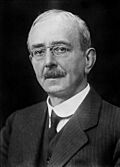 |
Sir Charles Scott Sherrington |
Neurophysiologist, histologist, bacteriologist, and pathologist |
| 44 |
1925–1930 |
 |
Sir Ernest Rutherford (later 1st Baron Rutherford of Nelson) |
Physicist and chemist |
| 45 |
1930–1935 |
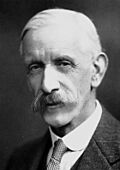 |
Sir Frederick Gowland Hopkins |
Biochemist |
| 46 |
1935–1940 |
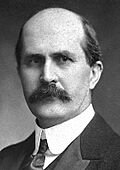 |
Sir William Henry Bragg |
Physicist, chemist and mathematician |
| 47 |
1940–1945 |
 |
Sir Henry Hallett Dale |
Pharmacologist and physiologist |
| 48 |
1945–1950 |
 |
Sir Robert Robinson |
Organic chemist |
| 49 |
1950–1955 |
 |
Edgar Adrian, 1st Baron Adrian |
Electrophysiologist |
| 50 |
1955–1960 |
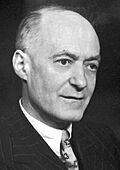 |
Sir Cyril Norman Hinshelwood |
Physical chemist |
| 51 |
1960–1965 |
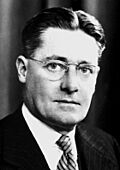 |
Howard Florey, Baron Florey |
Pharmacologist and pathologist |
| 52 |
1965–1970 |
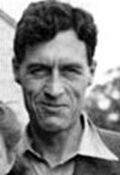 |
Patrick Blackett (Baron Blackett after 1969) |
Physicist |
| 53 |
1970–1975 |
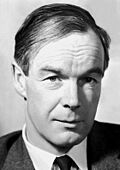 |
Sir Alan Lloyd Hodgkin |
Physiologist and Biophysicist |
| 54 |
1975–1980 |
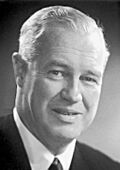 |
Alexander R. Todd, Baron Todd |
Biochemist |
| 55 |
1980–1985 |
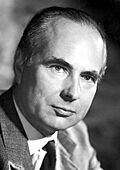 |
Sir Andrew Huxley |
Physiologist and biophysicist |
| 56 |
1985–1990 |
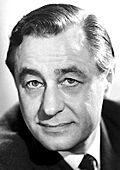 |
Sir George Porter (Baron Porter of Luddenham after 1990) |
Chemist |
| 57 |
1990–1995 |
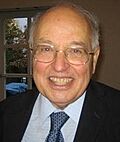 |
Sir Michael Atiyah |
Mathematician |
| 58 |
1995–2000 |
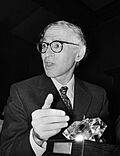 |
Sir Aaron Klug |
Chemist and biophysicist |
| 59 |
2000–2005 |
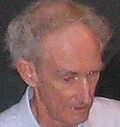 |
Sir Robert May (Baron May of Oxford after 2001) |
Mathematical Biologist |
| 60 |
2005–2010 |
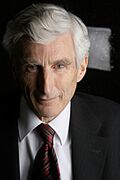 |
Martin Rees, Baron Rees of Ludlow |
Cosmologist and astrophysicist |
| 61 |
2010–2015 |
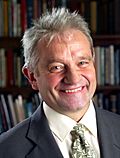 |
Sir Paul Nurse |
Geneticist and cell biologist |
| 62 |
2015–2020 |
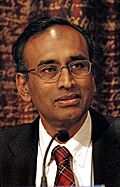 |
Venki Ramakrishnan |
Biophysicist |
| 63 |
2020–present |
 |
Sir Adrian Smith |
Statistician |
































































